The Parents
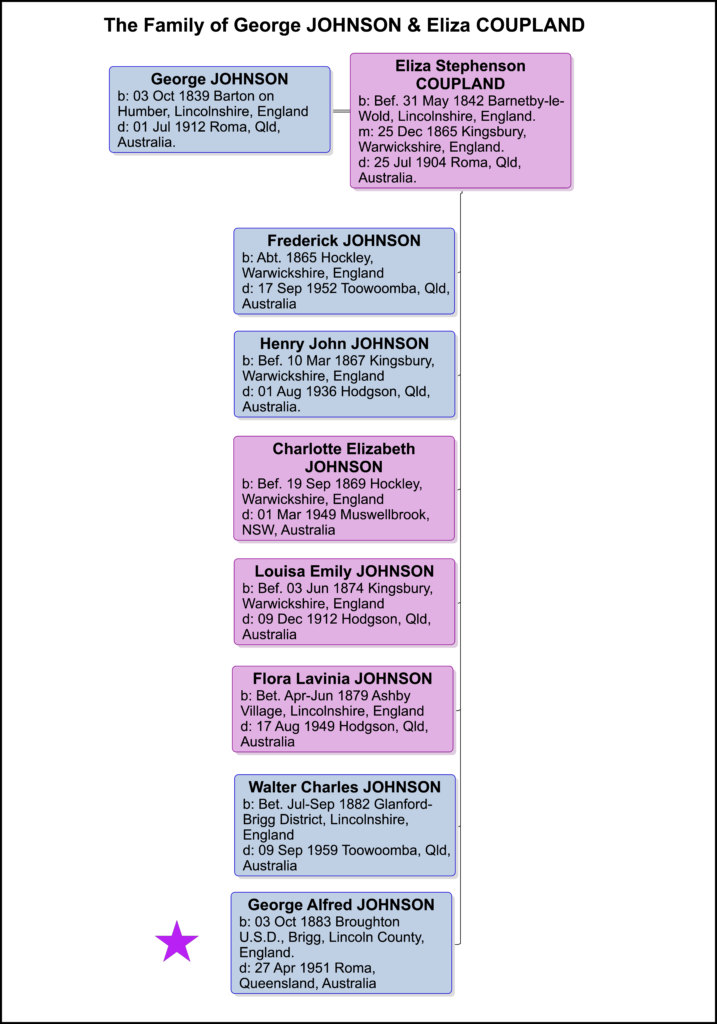
George Johnson
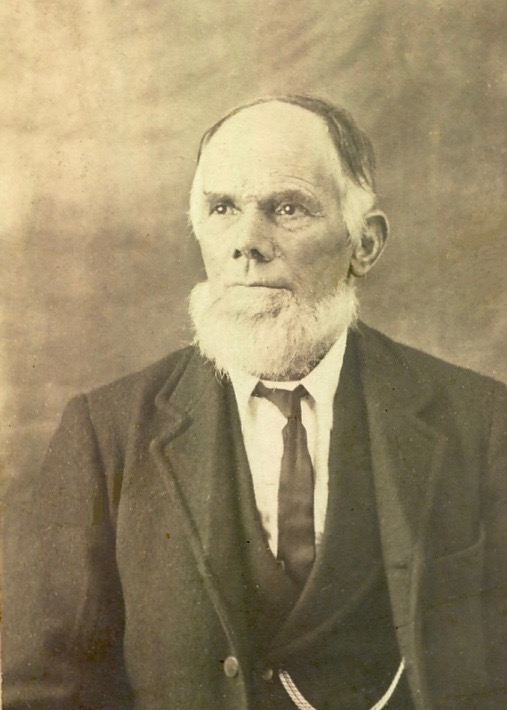
George Johnson was the third son of eleven children of John Johnson and Sabina Codd. He was baptised on 20 October, 1839 at St Peter’s Church of England, at Barton-Upon-Humber in Lincolnshire.

George would have spent about the first 10 years of his childhood in the village of Worlaby before settling for any length of time in Horkstow. We can see this from where his siblings were born and also the census of where the family was living over the years.
Even though George is listed as being a scholar in the 1851 census when he was about 11 years of age, he probably would have taken time off from studies to help in the fields at harvest time. This would also help with the family budget.
It is mentioned in a book ‘The Farthest Promised Land’ by Rollo Arnold, that the many children left school to work in the fields.
“Charles Winter, the Caistor schoolmaster, found that the demands of agriculture undermined the work of his school. He mentioned the ‘The children from 8 to 12 years old all leave the school here in March and don’t come back till November, except for an odd day or two sometimes…..but there are lots of families here who never send their children at all.1
The family finally settled in Horkstow in about 1851 and George stayed there for at least 10 years becoming an agricultural labourer like his father.
Eliza Stephenson Coupland
[If any descendant has a photo fo Eliza Stephenson Johnson (nee Coupland), I would much appreciate it.]
Eliza was the oldest child of six children of John Coupland and Charlotte Stephenson. She was born in 1842 and baptised on 31 May of that year at St. Mary’s Church of England at Barnetby Le Wold.

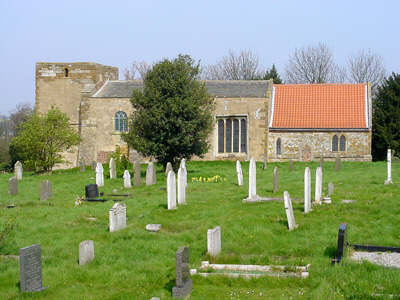
After the Norman conquest of 1066, a church was built on the hillside just above the village of Barnetby, consecrated to St Mary. The tower was built in the 11th-12th century, and the tower arch, the north arcade, and the chancel date from the 13th century. More alterations were made in the 17th-18th centuries. The font in St Mary’s is said to date from the reign of King Stephen – 1135-54.
In 1927, the church became redundant and the congregation began using St. Barnabas Church, a brick structure about a kilometre in Barnetby.
The Coupland family shifted from Barnetby to Barton and then around 1847 settled in Horkstow. They were living only two doors away from the Johnson Family in 1851 and living right next door in 1861.
Possibly because Eliza was the eldest, she would have helped her mother with her younger siblings although she was lucky as the Coupland’s had a house servant as shown in both the 1851 and 1861 census. However, Eliza never learned to write her name as shown in her marriage certificate.
Eliza’s father started life as an agricultural labourer but worked his way up to being an Estate or Farm Bailiff. A Bailiff is an overseer or under steward on an estate (or farm), who directs husbandry operations and collects rents etc. Perhaps he even employed George Johnson and his father John.
Between 1861 and 1865 the Coupland family made a great change in their lives and moved from Lincolnshire to Warwickshire. Eliza may have already been engaged to George as she would have been about 20 years old. And George, not wanting to lose Eliza, moved to Warwickshire as well.
Marriage
We know that the Coupland family and George had moved to Kingsbury in Warwickshire before 1865 as Eliza and George were married there on 10 December of that year.
From the parish register, we can see that George was living at Hockley Hall where his wife and father-in-law also lived. Perhaps this was the farm that John Coupland owned and George was working for him. Also we can see that George signed his name but Eliza only made her mark. Her brother, George Coupland, was a witness to the marriage.

The Church of St. Peter & St. Paul in Kingsbury, where George and Eliza were married, dates back to the 12th century. The stones of the church porch show evidence of arrow-sharpening grooves, sometimes said to have been done by soldiers but more probably by hunting parties or locals waiting their turn for the nearby village butts, as all males had to be proficient with a longbow.’3
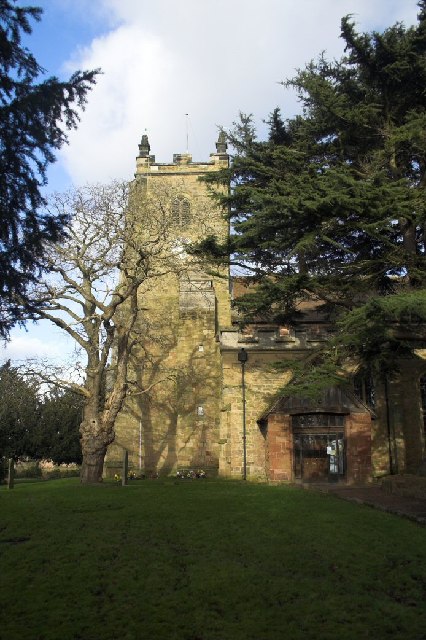
St. Peter & St. Paul, Kingsbury.
Kingsbury was a large village and parish in North Warwickshire and situated between Birmingham and Tamworth and overlooked the River Tame. Until the 19th century it was a small hamlet, and the main landowner in the area was the Prime Minister Sir Robert Peel. The Birmingham and Derby Railway was built through Kingsbury in 1839 and industry was soon established, most notable coal mining and gravel extraction, which fuelled the expansion of the village.4
By 1871, George and Eliza had three children, Fred, Henry (Harry) John and Charlotte, and were now living at Hockley Road in Wilnecote. Charles (Eliza’s brother) and his wife and family were living next door. Both George and Charles were labourers.
During the next decade, between 1871 and 1881, the Johnson’s had a few more changes in their lives. Their family included another two daughters, Louisa and Florence (Florrie). They had returned to Lincolnshire and resided in Ashby Village, next to George’s brother Joseph and his wife Louisa. Ashby Village is now part of Scunthorpe.
‘Scunthorpe is an industrial town in Northern Lincolnshire. Scunthorpe as a town came into existence due to the exploitation of the local Ironstone (~25% iron average) resources and subsequent formation of iron works from the 1850’s onwards. Ironstone was mined by open cast methods from the 1850’s onwards until the 1930’s. The regional population grew from 1,245 in 1851 to 11,167 in 1901 and during the expansion, Scunthorpe virtually took over five villages including Ashby.’5
And the other change was that George was now a blast engine driver. One of the ‘big inventions’ of the 1700-1800’s was the steam engine. It not only brought the railways, but also steam engines now replaced ‘agricultural labourers’ in the fields and replaced windmills for draining the Fens. It also was used for pumping water out of coal mines. Oddly, many men found work in the coal mines to supply fuel for these ‘beasts’, while others worked in the iron pits around Scunthorpe because of the demand for iron and steel. Possibly George was working in the iron works in Scunthorpe.
George and Eliza had another two children after 1881. They were Walter and George Alfred (Alf), making seven children in the family.
Before 1888, George and Eliza made, perhaps, the biggest decision of their lives – to migrate to Australia. Why they did this we do not know for certain. Perhaps it was because Eliza’s brother Charles and his family, who had already moved to Australia and settled at Muswellbrook in New South Wales, sent back glowing reports of the country and opportunities for work. Or perhaps George had seen the emigration agents sent from Queensland, who were going around the countryside, conducting meetings and encouraging people to move to Australia.
One such agent was George Randall. More about emigration agents can be found here.
So, in October, 1887, George aged 48 years, Eliza aged 44 years , and their seven children, from the oldest Fred (aged 22 years) to the youngest Alf (aged 3 years) left Lincolnshire and journeyed to Plymouth, Devon at the south of England. That journey alone would have been most interesting for the family.
They were given ‘free passage’ by the Queensland government to travel on board the ‘Eastminster’ to Maryborough in Queensland, Australia.
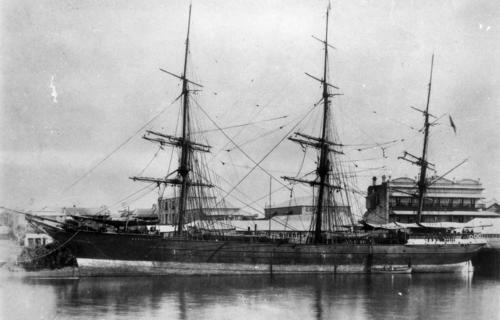
The ‘Eastminster’ was an iron ship of 1,145 tons and built in Glasgow in 1876. She was captained by R. D. Rees and departed Plymouth, England on 6 November, 1887 and arrived in Maryborough on 29 January, 1888. The journey took about 3 months and the Johnsons left in the beginning of their winter and arrived in Queensland in the middle of our hot summer.
The Johnsons were issued with a Passenger Contract Ticket on embarkation and had to have it on their person at all times so it could be viewed on demand. George, Eliza and the three youngest children, Florrie, Walter and Alf were issued with ticket number 4323. Girls aged above 12 years were berthed in Single Females’ compartment in charge of a Matron, and boys of 12 years and over were berthed with the single men. Therefore the older children would have been issued with their own ticket and lived in the separate areas.
The Contract Ticket is a valuable piece of information about the voyage out to Australia. It lists the amount of luggage a person could bring and what food was available per passenger. The copy of the Contract Ticket number 4323 is very hard to read so I have transcribed as much as I could read of the first page. The second page has the food listed per day with separate quantities for persons of 12 years and older and for children up to 12 years. (I have put metric measures in brackets).
PASSENGER’S CONTRACT TICKET
PASSENGERS’ CONTRACT TICKET.
1.- A Contract Ticket in this form must be given to every Passenger engaging a Passage from the United Kingdom to any place out of Europe, and not being within the Mediterranean Sea.
2.- The Victualling Scale for the Voyage must be printed in the body of the Ticket.
3.- All the Blanks must be correctly filled in, and the Ticket must be legibly signed with the Christian Names and Surname and Address in full of the Party issuing the same.
4.- The day of the Month on which the Ship is to sail must be inserted in Words, and not in Figures.
5.- When once issued, this Ticket must not be withdrawn from the Passenger, nor any alteration, addition, or erasure made in it.
Ship: Eastminster of 1,145 Tons Register to take in Passengers at PLYMOUTH, for MARYBOROUGH, on the 29th day of October, 1888.
I engage that the Person named in the margin hereof shall be provided with a STEERAGE Passage to, and shall be landed at the Maryborough in QUEENSLAND, in the Ship, Eastminster, with not less than Ten Cubic Feet for luggage for each Statute Adult, and shall be victualled during the Voyage and time of detention at any place before its termination, according to the subjoined scale, for the sum of £4, including Government Dues, before Embarkation, and Head Money, if any, at the place of Landing, and every other charge, except Freight for excess of Luggage beyond the quantity above specified, and I hereby acknowledge to have received the sum of £4 in full payment.
The following quantities, at least, of Water and Provisions (to be issued daily), will be supplied by the Master of the Ship as required by Law, viz.:-
To each Statute Adult, 3 quarts [3.4l] of water, daily, exclusive, of what is necessary for cooking the articles required for the Passenger Act to be issued in a cooked state; and a weekly allowance of Provisions according to the following scale: 3½lbs. [1.6kg] of Bread or Biscuit, not inferior in quality to navy biscuit, 2lbs. [907g] Wheaten Flour, 1lb. [454g] Oatmeal, ½lb. [227g] Rice, 1½lbs. [681g] Peas, 2lbs. Potatoes, 1¼lbs. [567g] Beef, 1lb. Pork, 2oz. [57g] Tea, 1lb. Sugar, 2oz. Salt, ½oz. [14g] Black or White Pepper, ground, 1 gill [142ml]Vinegar, 6oz. [170ml] Lime Juice; 1lb. Preserved Meat, 6oz. [170ml] Suet, 8oz. [227g] Raisins, 4oz. [114g] Butter.
SUBSTITUTIONS at the following rates may, at the option of the Master of any Passenger Ship, be made in the above Dietary Scale, that is to say,- 1lb. of Preserved Meat for 1lb. of Salt Pork or beef, 1lb. of Flour or of Bread or Biscuit, or ½lb. of Beef or of Pork, for 1¼lb. of Oatmeal, or 1lb. of Rice or 1lb. of Peas, 1lb. of Rice for 1¼lb. of Oatmeal, or vice versa, ¼lb. of Preserved Raisins, 3½oz. [99g] of Cocoa or Coffee, roasted and ground, for 2oz. of Tea, 3/4lb. [340g] of Treacle for ½lb. of Sugar, 1 gill (1/2 cup) of Mixed Pickles for 1 gill (28mls)of Vinegar. N.B. – Mess Utensils and bedding to be supplied by the Passengers.
On behalf of……………………. London,. Total ₤4.
Voyage
The following extract is taken from the book ‘Poorhouse to Paradise’ by Lyall Ford. It gives a little history of the ‘Eastminster’ and also a description of the voyage out to Australia.
Voyage of ‘Eastminster’
The ‘Eastminster’ would have been one of the last sailing ships to operate on the run to Australia, as steam-powered vessels were gradually replacing the sailing ships. Before the Suez Canal opened in 1869 all ships traveled to Australia around the Cape of Good Hope in South Africa and returned via Cape Horn in South America. They utilized the westerly winds known as the Roaring Forties (referring to the degrees of latitude south of the Equator). Although the Suez Canal shortened the journey by over 5,000km, it was unsuitable for sailing ships as the winds in the northern part of the Indian Ocean blew from the East.
The general layout of all the emigrant ships was fairly similar. There were usually two decks – the top deck which consisted of cabins for the first class passengers, and the lower deck, or ‘tween-decks, for the steerage passengers. Prior to 1852, although the cabins were often superbly finished, the steerage accommodation usually had rough bunks and temporary partitions, since these could be dismantled at the end of the outward voyage in order to receive cargo for the return trip to England. Hence the upper deck passengers would have a relatively comfortable trip but conditions for the steerage passengers were often horrendous. The 1852 Passenger Act improved things somewhat by insisting that passengers had to be carried on decks with a minimum headroom of 7 feet 6 inches (2.28m). It also required the separation of unmarried women, unmarried men and married couples. (The ‘Eastminster’ was divided into two compartments by an airtight bulkhead.)
There were still problems however. It was difficult to provide adequate lighting and ventilation ‘tween decks. If hatches were left open for this purpose a freak wave would sometimes send water pouring into the steerage section and this would slosh around wetting everything and generally making life miserable. These conditions and the tropical heat and humidity, combined with the poor food and little exercise, would often lead to the spread of disease on board.
The ‘Eastminster’ was making its second voyage to Maryborough, having arrived previously in March 1887. It was again under the command of Captain R.D. Rees, the Surgeon Dr Cecil and the Matron Mrs Cochot. Captain Rees was approaching the trip with some trepidation, as he had previously taken his son with him on a similar trip to Maryborough but the boy had bolted from the ship and the father had to return home without him. The mother was naturally very distressed when he came back without their son. He was determined to put in a special effort to locate him when he arrive in Maryborough this time.
The ship was delayed several days in London because of a raging gale in the English Channel but finally departed on 4 November, 1887 and arrived at Plymouth on the morning of the 6th. After embarking the emigrants it left at 8.30 pm in tow of a steam rug and was let go at Breakwater. On board were 129 single men, 53 single girls, 28 married couples and 44 children – all looking forward to a promising future in the Colony of Queensland. None of the passengers, or the crew, would have realized what an eventful trip this was going to be.
The Captain at once set all sail as breezes were moderate, but these conditions only lasted two days, when heavy squalls and passing showers ere experienced. Conditions moderated again the next day and they experienced light to fresh winds and occasional showers of rain until 12 December when heavy swells were encountered. These continued on and off until 6 January, with the ship continually labouring heavily and occasionally shipping large quantities of water.
Many of the emigrants began to wish that they had never left, for most of them became seasick from the extended rough weather. Conditions were extremely uncomfortable with the over-crowding, the heat and humidity, the continual pitching and heeling of the ship, water sloshing around on both the upper and lower decks, the stench of vomit down below, and poor food for those who could eat it. When it became particularly rough the women donned life jackets, sang hymns and prayed that they would survive, while the wind whistled through the rigging and masts groaned as the stays strained to support them against the gale force winds.
On 28 December while in this heavy weather one of the starboard davits (lifeboat lowering system) was carried away; and in January one of the emigrants named James Oswald was washed against the side of the deck by a tremendous wave and had his leg broken.
With these conditions it was no wonder that there was an outbreak of measles. This spread rapidly and 33 cases were reported, mostly among the children. Fortunately there wasn’t an outbreak of ship fever (typhoid) as was so common among the emigrant ships of the 19th century. However, the measles was bad enough and it was difficult containing the epidemic on such a relatively small ship. There was much anguish among the passengers but the Captain, Surgeon and Matron handled matters well. All on board were relieved when the last case recovered about two weeks before the end of the voyage, as this time was required to allow the ship being granted pratique (‘permission to hold intercourse given to a ship after compliance with quarantine regulations or on presenting a clean bill of health’). If this hadn’t been granted by the Medical Officer at the port of arrival the passengers would have been put into quarantine and would have had to endure up to a further month in prison-like conditions before being released into the community.
On a happier note there were two successful births during the voyage.
The travel time for sailing ships was usually over 100 days, but the ‘Eastminster’ performed well despite (or because of) the rough weather and it sailed under the White Cliffs at the mouth of the Mary River in Queensland after only 84 days at sea. It would have arrived even sooner if it hadn’t been for headwinds encountered on the run up the east coast of Australia. It was towed up the river to Maryborough the next day, Sunday 29 January 1888, where the immigrants disembarked. They spoke in highly satisfactory terms of the Captain, Surgeon and Matron for their kindness during the voyage, which was a contrary attitude to that commonly expressed by immigrants arriving on many other ships.
The next morning the passengers presented themselves at the immigration depot for hiring.
When Captain Rees arrived in Maryborough on the ‘Eastminster’ he received a pleasant surprise as his missing son came on board to meet him, and agreed to accompany him on the trip back to England.
The next assignment for the ‘Eastminster’ was to proceed to Newcastle and load coal for San Diego. By Friday 17 February 1888 it was ready to depart with its crew and a passenger, Ted Taylor, but there was no great hurry as it wasn’t due in Newcastle until the end of February.
The weather along the whole eastern coast of Queensland was wet and windy that day and cyclonic gales were forecast overnight. The ‘Eastminster’s’ pilot warned Captain Rees that he should not be leaving port but should wait for better weather. The captain ignored the pilot’s advice but no one knows why he felt impelled to press on in such atrocious weather conditions. However, this decision turned out to be a foolhardy one as his poor wife back in England was to lose both her husband and her son as a result of this folly.
The ship was towed to Woody Point and farewelled by the pilot as it headed for Newcastle that fateful Friday night.
It was some time before it was realized that the ‘Eastminster’ was missing and Thursday 1 March before the Rockhampton Harbour Master set out to search along the coast for both it and the brigantine Kate which was also missing. On 3 March the Maryborough Chronicle reported that there was very little hope of the ship being safe:
‘All the particulars point to her being wrecked on the same night that she left Woody Island. A fearful gale was blowing that Friday night, and the unfortunate vessel being in narrow waters was probably unable to beat out to sea, and struck upon on of the numerous reefs north of Breaksea Spit. The firing of rockets, the discovery of wreckage, and the fact that nothing has been heard of the vessel, all combine almost to dissipate hope.’
In the extensive searches that followed, a small amount of wreckage was found on North Keppel Island. Local aborigines had made a humpy out of the stern of a boat on which was painted the words ‘Eastminster’, London’. Searchers also found an ‘Eastminster’ life buoy and a piece of timber with the word ‘Eastminster’ in a semi-circle over a picture of a church carved in the wood. It also transpired that on the Friday night, when the cyclone was at its height on the coast, rockets were seen and firing of guns heard at Yeppoon, but nothing was thought of the matter because nothing unusual was seen the next day.”
The loss of the ‘Eastminster’ was mentioned in many newspapers in Australia and also at least 60 articles were written in newspapers in England. In December of 1888, it was written in the Manchester Courier and Lancashire General Advertiser ‘that a Frenchman, French Pete from Emu Park, had discovered a sunken wreckage inside a coral reef about 100 miles from Emu Park about Keppel Island. There were Indications that here had been some survivors from the wreck, as shown by the marks of habitation of the reef itself’. Also mentioned in another newspaper, the Shields Daily Gazette on 4 June, 1888 was that all the passengers had lost their lives. This was corrected to just the crew in newspapers several days later.
Arrival in Queensland
As mentioned in ‘Poorhouse to Paradise’, many of the immigrants were available for hiring on arriving at Maryborough. Whether George had already an arrangement before arriving or was hired by an agent in Maryborough is not known. However, the Johnson family made their way to Roma on the western Darling Downs of Queensland.
It would have be a memorable trip for the family. They had come from a lush green land of small farms, with villages only several kilometres apart and smoke/fog filled cities. The temperature, when they left, would probably had been around 1 degree as it had snowed on the 11 October in London that year.
The Johnson family had suffered through a very bad voyage out and landed just as a cyclone was hitting the coast around the Maryborough area. And then they had to travel about 600 kilometres over bumpy roads through vast wooded areas and much drier landscapes which were sparsely populated to Roma. The temperatures would have been around 30 degrees, much hotter than the near freezing temperatures they had left behind.
Reading Farm
As mentioned in ‘Mate’s Story’ by Geoff Johnson (son of Alf), George Johnson obtained work on Reading Farm and reportedly worked there for about 12 months. R.B. Taylor wrote a book ‘The History of Roma and District’ and describes the beginning of Reading Farm’.
‘Just North-East of the Minmi Crossing, a Conditional Purchase of 640 acres was taken up by Mr. Benjamin Leach on the 25 July, 1883. By the following April the land had been fenced and commodious dwelling house and other smaller buildings erected on it and about 30 acres cleared. “It is Mr. Leach’s intention to make an extensive vineyard.” Mr Leach named his property ‘Reading Farm‘ and in subsequent years, but only for a comparatively short time, it was one of the show places of the District.’6
‘Reading Farm ‘was later owned by the Queensland National Bank in 1894. An advertisement for its Sale or To Let was in the Western Star on 17 July, 1895 and gives a good description.42519c
The older sons Fred (aged 23) and Henry John (aged 21) also obtained work in the district. George and the younger family then shifted to New South Wales for four or five years.7 No doubt, this was to Muswellbrook where Eliza’s brother Charles Coupland and his family were living.
Charles had been in Australia since 1883 and was well established as he was the Manager of ‘Overton‘. This was a large property with sheep, cattle and horses, especially Clydesdale or draught horses. In the NSW 1891 census, there is mention of Charles with his family at ‘Overton” and also living there was a G. Johnson with 3 males and 4 females. These could have been the younger children and Eliza.
One thing ‘Overton‘ was noted for was its prize draught horses. One such horse was ‘Cannie Scot’ which was imported from Scotland and was bought by the owner of ‘Overton‘, Mr G Blunt. This stallion went on to win numerous prizes in New South Wales. It is probably here that the Johnson family found a love for Clydesdales.
Perhaps George and family stayed at ‘Overton‘ for several years and may have been there to help Lavinia Coupland as Charles unexpectedly suffered a heart attack and died in May 1893 at the young age of 43 years.
It is mentioned in ‘Devine by Name…’. a Family History by Peter Devine that several lots of land at Kayuga outside Muswellbrook were transferred from George Johnson to his daughter Charlotte on 31 December, 1913. This was just after George’s death and does show that he had bought land down there.
However, we do know that the Johnson family were back in Hodgson by 1897 as there is a copy of youngest son Alf Johnson‘s school exercise book from that year. Extracts from this exercise book can be found in Alf‘s story.
Wool Industry and the Johnsons
The wool industry had commenced in the 1840’s and by 1860 had become the primary export earner for the newly established colony of Queensland. The first patent for a shearing machine was granted in 1867 and the growing sheep population provided ample incentive for the inventors to create a machine that would save shearers from the tyranny and agony of hand shears. However, it wasn’t until 1887 that the first shearing machine was successfully demonstrated. In the late 19th century steam engines provided the power to the line-shaft of these machines.
On returning to Hodgson, George would have obtained work as a labourer on the surrounding properties but he was also engaged as a steam-engine driver for the shearing machines in the wool-sheds in the district and further west.
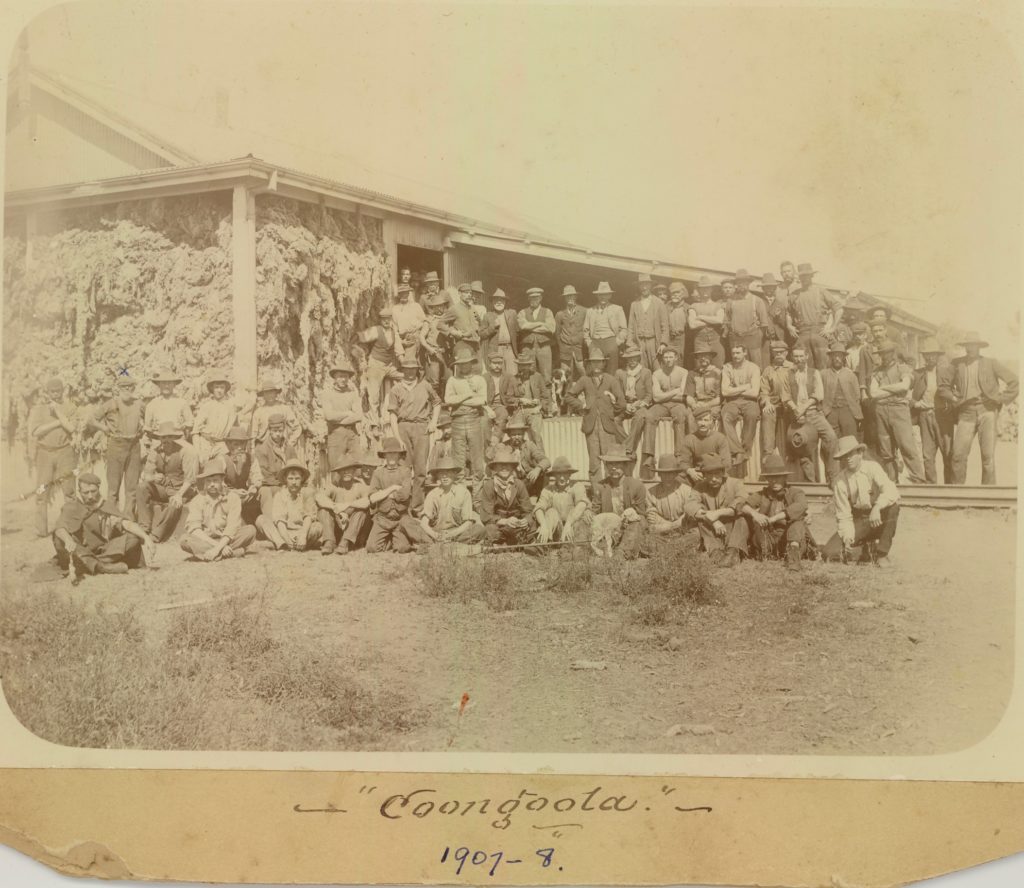
The above photo was taken in 1907-08 at ‘Coongoola‘ sheep station at Cunnamulla. It shows the shearing team at the finish of shearing. George Johnson is standing in the second front row, second from the left with his hands on his hips wearing a cap (with a small ‘x’ over his head). A more detailed photo can be found here.
Not only was George involved with shearing through the use of his steam engine licence, but his son Alf also took up shearing and passed the occupation on to his sons.
Land Selection
The process of land selection (as opposed to sales) began in Queensland in 1860 and continued under a series of land acts thereafter. Land was considered the colony’s greatest asset. Prosperity of the colony was measures according to the extent of land settlement. Rent from land leases was the colony’s largest revenue earner. The initial political contest was between pastoralists and selectors lead by the ‘town liberals’ who desired that immigrants have an equitable right to small land holdings. Closer settlement for agricultural purposes was promoted by the British government who desired settlement by immigrants to Queensland and exports of agricultural produce and raw materials such as cotton and wool.8
In the mid to late 1890’s, land was thrown open for selection in the Hodgson area and one place was the upper Dargal Creek, about 20 kilometres north west of Hodgson. In 1898, George, and his son Fred applied and were successful in obtaining four blocks each of 160 acres making a grand total of 640 acres, being portions 219v and 220v for George and portions 193v and 218v for Fred.9 George application was certified for lease in 190310 and in 1907, the land was certified for lease.11. Fred, being married with a young family, took up his two blocks next to George and Alf and worked his property ‘Fairholme‘ as a separate unit.
More research about fulfilment of land selection, also the blocks size portion etc from State Archives needed.
In 1904 on 25 July at Hawthorne Street in Roma, Eliza Johnson died of inflammation of the kidneys (intestinal nephritis) and valvular heart disease. Eliza was just over 63 years and she was buried a day later on 26 July at Hodgson Cemetery by Andrew Dunn, Presbyterian minister.
Sacred
To
The Memory of
ELIZA STEPHENSON JOHNSON
Who Died on 25th July 1904
Aged 63 Years
Nothing in my hand I bring
Simply to thy cross I cling
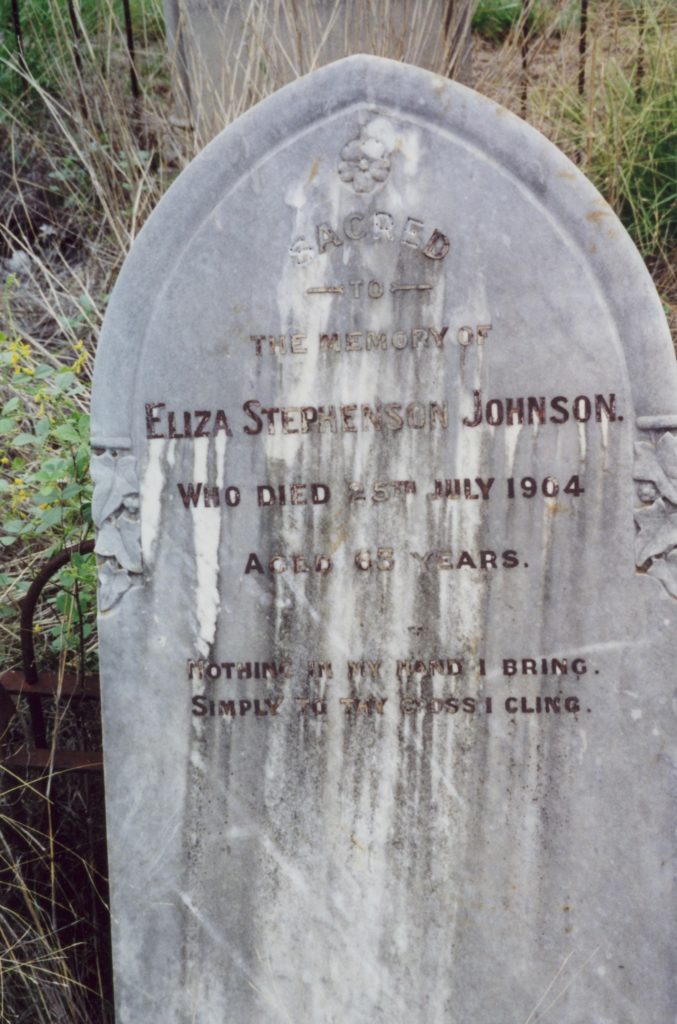
When shearing was not in progress, George and Alf continued working on their selection ‘Fernvale‘ – clearing the land by hand using a grubber or mattock (similar to a pickaxe) and then burning the felled trees. After this the paddocks were ploughed with a three wheeled plough pulled by two horses. Often these horse were draught horses. Although each block had a frontage to Dargal Creek, the waterholes were not of a permanent nature so there could be problems when the drought developed in dry times.12
George survived Eliza for another eight years and died on 1 July, 1912 at the Roma Hospital. He had no doubt been ill for some time as he had suffered a stroke and was paralysed down one side of his body and had developed bronchial-pneumonia. The witnesses to his burial were son Alf and John W. Aisthore. John Aisthorpe’s daughter Olive married Elon Woodcroft who was the son of Florrie Woodcroft (nee Johnson) – George’s daughter. George was nearly 76 years old.
George was buried next to Eliza in the Hodgson Cemetery.
In
Loving Memory
Of
GEORGE JOHNSON
Who Died July 1st 1912
Aged 75 Years
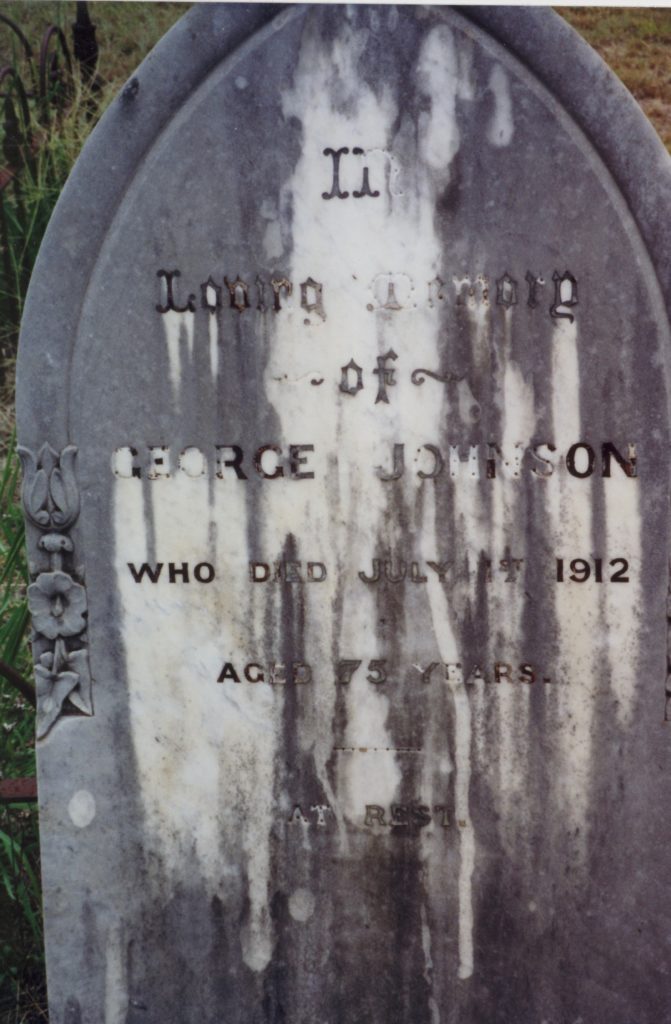
Children
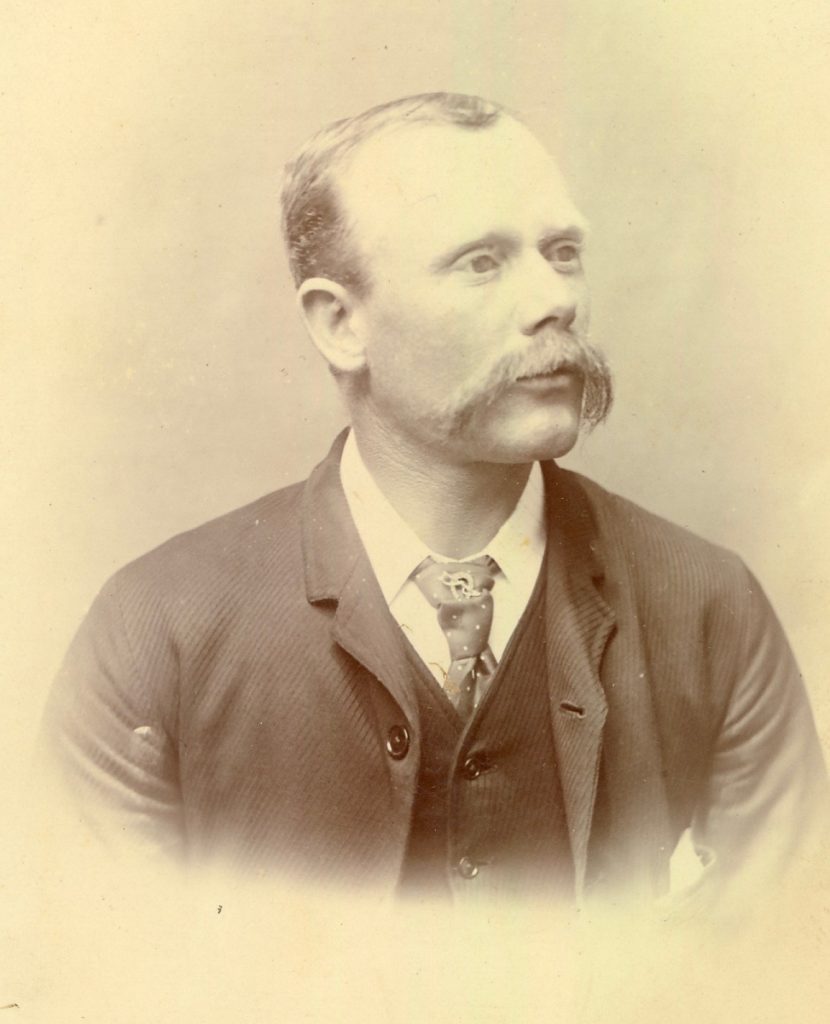
Fred Johnson (b. about 1865) married Harriett Mary Keegan (b1879 in Murrurundi, NSW) on 8 October, 1902.13 They had six children: Clarence Coupland (1904); Leslie Alfred Stephenson (1905); G ertrude Eliza (1907); Irene Veronica (1909); Alfreda Harriett (1911-1912); and Alan Francis (1918).
In 1891, Fred applied for 68 acres, Portion 35V, of Government land at Hodgson at the Roma Land Court. This application was approved. Five years later in 1896, he had fulfilled the conditions for keeping the farm. Portion 35V is situated south of the present Hodgson township right next to the Warrego Highway. His brother Henry John applied for the block, Portion 36V, next door.
Fred and Harriett took up two blocks of land (portion 220V & 221V) next to his father George and brother Alf on the upper Dargal Creek. They named that block ‘Fairholme‘ and worked it until Fred sold it to Alf in about 1927. By 1936, Fred and Harriett were living at William Street, Roma and he was a selector.14 Fred continued labouring on properties in the area and was working at ‘Beilberango’, Yuleba in 1943.15 Harriett was at 21 Partridge Street, Toowoomba at this time.
Harriett is listed at this address as the person of contact for her son Alan when he joined the Royal Australian Air Force (RAAF) in 1942. Perhaps Harriett lived in Toowoomba which Fred worked out west. Fred died in 1952 and was buried at the Drayton cemetery. Harriet died in 1967 but I have not found a grave for her yet.
Of their children – Clarence Coupland was a contractor working at ‘Beilberango’, Yuleba from 1936 and was still there in 1943. Alan Francis, who was a milk vendor in Toowoomba, joined the RAAF and was killed in a flying battle over the Bay of Biscay in May 1944. He is listed at the Runnymede War Memorial. Leslie Alfred Stephenson, who was a labourer in the Roma District, died in 1951.
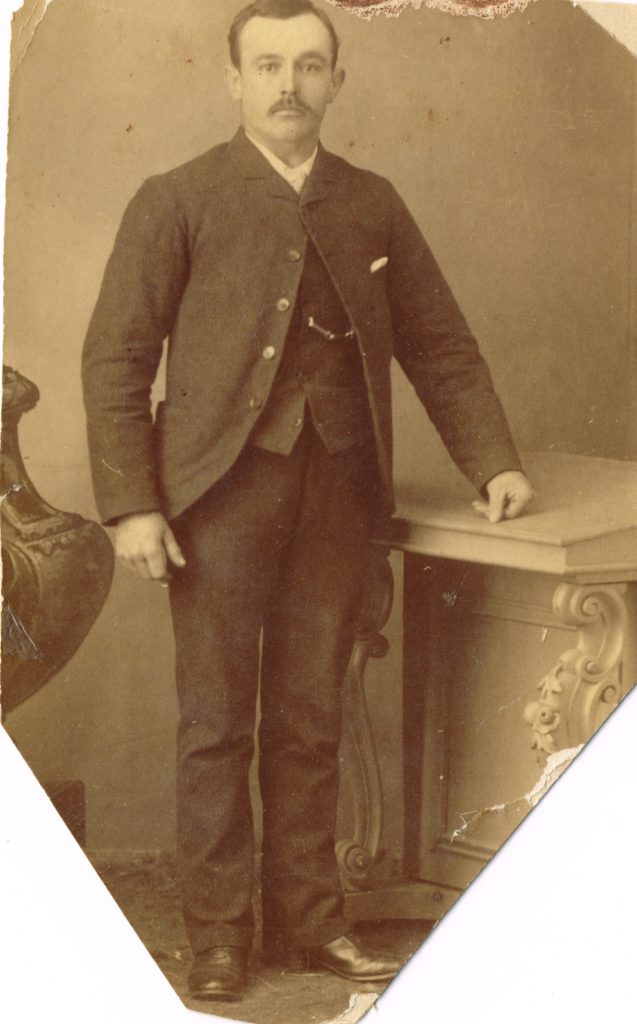
The following is taken from the obituary for Henry John Johnson – second son of George and Eliza, with added comments to bring it in to perspective with the rest of the family. It appeared in the ‘Western Star and Roma Advertiser‘ on 8 August, 1936.
‘Henry John, who as about 18 years old when he arrived iwht his parents on the ‘Eastminster’, secured his first employment at Bourne’s Cordial factory in Roma. However, his ambition was for the land and he secured hiss next job with Mr. James Nimmo at Hodgson, and while there he selected his first venture in land, 48 acres in 1891. In 1893, he married Ann Benyon Rayner, and started his wheat-growing career by planting 20 acres three years later. This land would have had to be cleared by hand similar to George and Alf’s. He followed up shearing during the wheat-growing season, and later, in partnership wit James Stevenson, and then Reuben Plummer, carried on contract tank-sinking, in all corners of the Maranoa District. In 1911, after securing further wheat land at Hodgson and grazing land on the Donnybrook, he turned his attention to combining sheep with wheat-growing. In 1920, Mr. Johnson produced 380 bags of wheat, besides over 100 tons of hay, and at the time was the largest individual wheat producer in the Maranoa, if not Queensland. Mr. Johnson was always an advocate for water and fodder conservation, which practice is evident by the water facilities on each of his properties and the two large hay sheds which stand at Hodgson filled with hay. In 1922, ‘Lenroy’ was purchased, and which under his management now ranks among the best improved properties in the district. He always took a keen interest in the breeding of good stock. Although during his later years, he could not do any active work, he was always looked to for his sound advice.
Mr Johnson was the type of immigrant that this country is so badly in need of today to help develop these empty spaces. He leaves a widow, four sons and four daughters to mourn their loss. The sons are Messrs. Cecil, Victor, Norman and Douglas, and the daughters are Mrs. Wm. Stinson ‘Moscow’, Roma, Mrs W.H. Cary, Hendra, Brisbane, and Mrs V.E. Andrews and mrs D. Dickie of Hodgson.’
Ann Rayner (b.1876) was the daughter of Benjamin Rayner who was known as the ‘Mayor of Hodgson’, being the owner of the General Store and Hotel.16 Henry John and Ann had married in 1893. Henry John and Ann had another two children other than those mentioned in his obituary. These children, Vivian George (1893-1894) and Leslie Alfred (1908-1910), died as infants.
Henry John died on 1 August, 1936 and Ann died on 5 June, 1956. They are both buried in the Hodgson cemetery.
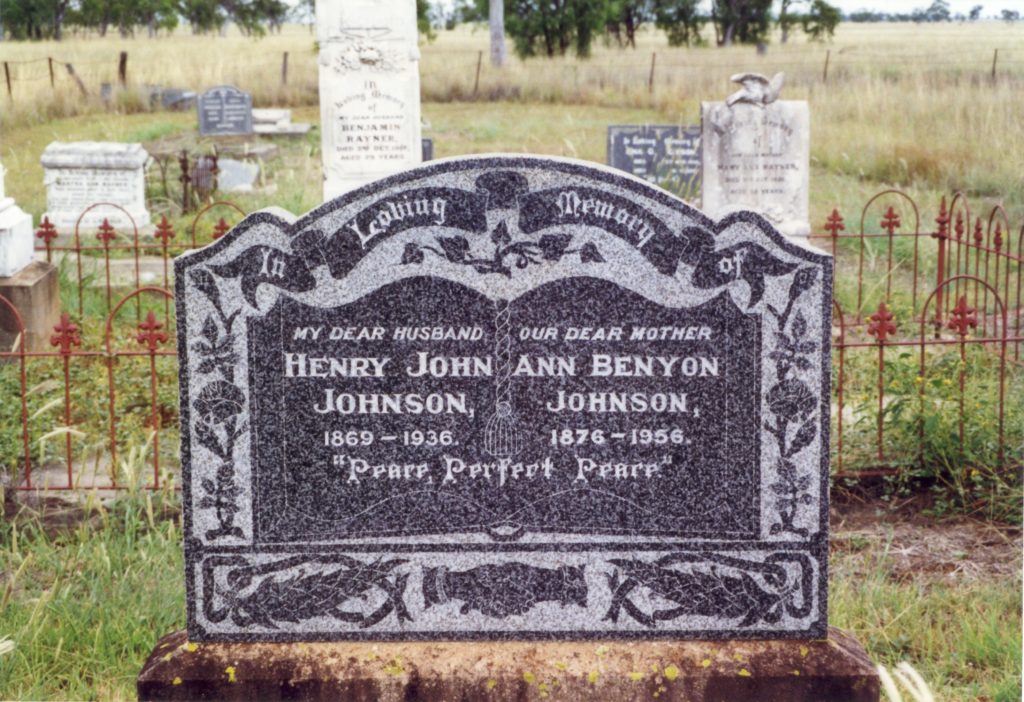
Hodgson Cemetery.
If you have any more information,
Could you please contact me so I can add to this story.
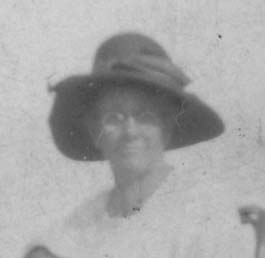
Charlotte Elizabeth Johnson was George and Eliza’s third child and first daughter. She would have been about 18 years old when she traveled out to Australia on the ‘Eastminster’ with the rest of the family.
Charlotte possibly met her future husband, Charles Devine, when the Johnson family went to Muswellbrook just a few years after they arrived in Australia, or when visiting her uncle and aunt – Charles and Lavinia Coupland – who also lived in Muswellbrook. Or perhaps, Charlotte came to help her aunt with her small children, when Charles unexpectedly died in 1893 at age 43 years. Another theory was that she may have met Charles when he was a shearer as he worked in Queensland during the Shearer’s strikes of 1891 and 1894.
Charlotte and Charles were married on 13 January, 1897 in St Andrew’s Church, Kayuga, just outside Muswellbrook. They had four children, Allan Charles (b. 1897); Roy Stephenson (b.1899); Heather Eliza (b.1904) and Winifred Louisa (b.1905). After working as a shearer, Charles did labouring , possibly on his mother’s farm at Kayuga. He eventually became a bootmaker with his brother John in the business ‘Devine Brothers Bootmakers’.
Charles died in 1942, aged 71 years and Charlotte in 1949, aged 80 years. They are buried in the Muswellbrook cemetery.
Louisa Emily Johnson – the fourth child and second daughter of George and Eliza was about 14 years old when she came to Australia with the family. Louisa married William John Plummer (b.1871) on 25 December, 1894.
Louisa and William had seven children – Irving William Walter (b.1896); Eileen Catherine Eliza (b.1898); Donald Alfred (b.1901-1902); George Allan James (b.1903); Phyllis Lavinia (b.1905); Conal Reginald (b.1908); and Cevin (Kevin Rupert Edgar (b.1911)).
In the early years of their marriage, William was a shearer, labourer and also worked on the 77 Gang of the South and West Railway. In 1905-06, he and Louisa and family were at the Angellala Siding, where he worked as a lengths man. William was a shearer when he applied for a licence for a hotel in Hodgson in 1906. William obviously received the licence as he was the owner of the hotel where James Murray had his last drink and is mentioned in the inquiry into James’ death (see James Murray Story). He continued being a licenced victualler at least until 1913 as listed in the Electoral Roll.
Cevin was born on 6 September, 1911 and Louisa died just over a year later on 9 December, 1912. She was buried in the Hodgson cemetery.
By 1925, William was staying at Keay’s boarding-house in Charleville and was a stockman. He died on 24 February, 1933 and was buried in the Drayton Cemetery in Toowoomba.
Cevin, their youngest son, joined the Australian army in 1940 and was a gunner with the 2 Australian anti-tank regiment in the Middle East. Cevin was killed in July 1941 and is buried in the Damascus British War Cemetery, grave H27.
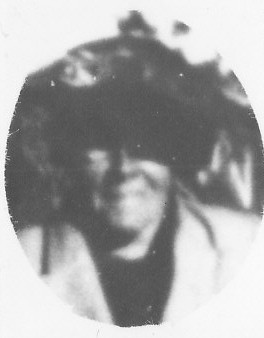
Florence Lavinia (Florrie) Johnson was about 9 years old when she arrived in Australia. She would have continued her education probably at the Hodgson School. Florrie married Charles Woodcroft on 25 December, 1901. Charles was born at ‘Burncleuth‘, Dalby in February 1869. It is interesting to note that both Florrie and her sister Louisa were both married on Christmas day. Perhaps, the men couldn’t get many holidays or it was an occasion when all the family was together so one celebrated as many things as possible on that day. However, it also may have been a family tradition as their parents were married on Christmas day back in England.
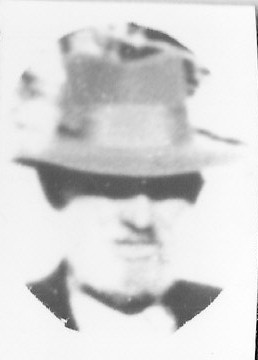
Charles and Florrie lived on Bindango Station, west of Hodgson for many years. Charles worked here as a boundary rider and also did stock work. He was also the mailman from Hodgson at times. They continued living in the Hodgson area for the rest of their lives.
Florrie and Charles had four children – Percival Charles George (b.1903); Elon Alfred (b.1905); Alma Thelma (b.1906) and Clarice Muriel (b.1915). Percival was a carrier and Elon became a labourer and woolpresser working in shearing sheds.
Charles and Florrie fell ill in 1949. I’m not sure what of, but there was a message in the Western Star & Roma Advertiser where their son Percy thanked Dr. Main and hospital staff for looking after them in their illness. Perhaps this illness contributed to their deaths.
Charles died on 13 June, 1949 and Florrie died two months later on 17 August, 1949. They are buried in the Hodgson cemetery.
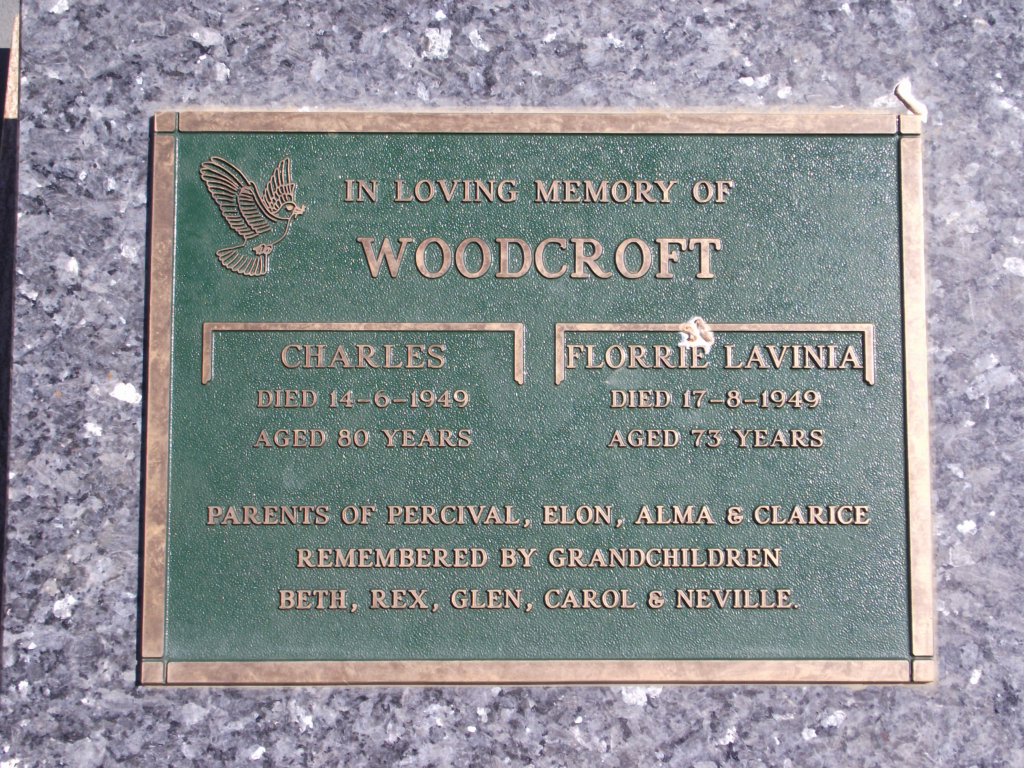
Hodgson Cemetery.
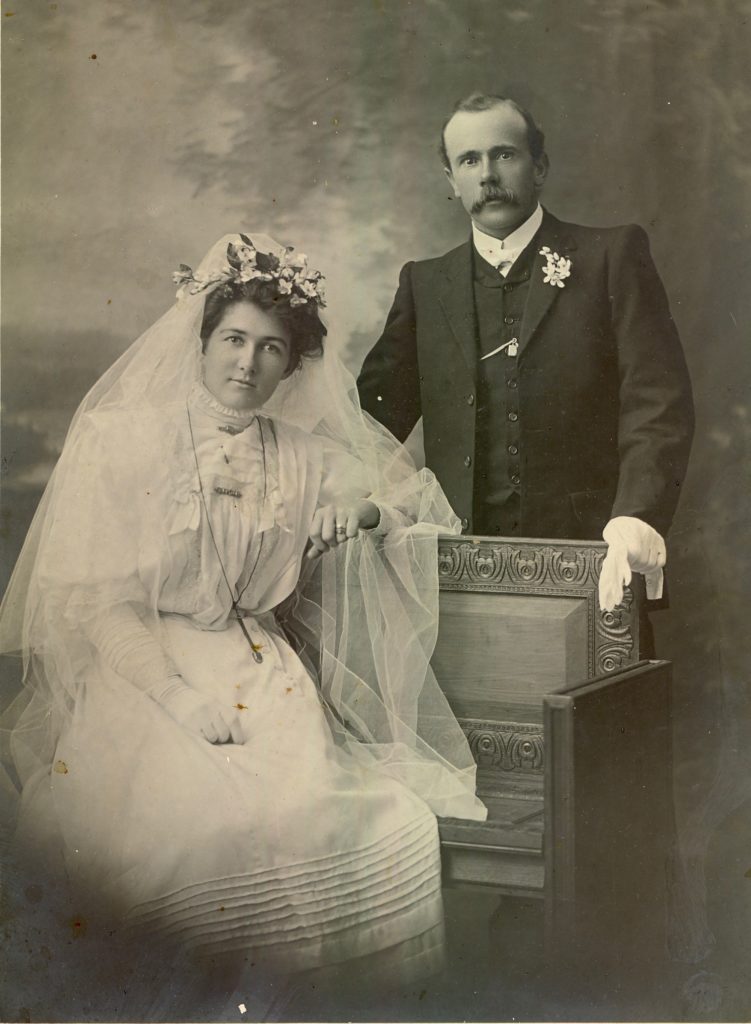
Walter Charles Johnson, the second last child, was 6 years old when he arrived in Queensland. He would have joined Florrie and Alf in his education at Hodgson School.
Walter was obviously different to his brothers by not being a shearer/grazier. By the time he was 23 years old in 1905, he was working as a cleaner in Toowoomba. Three years later, in July 1908, he married Mary Rendall McNeill (b.1883) and was a fireman. By 1925, Walter had become a locomotive engine driver with the Queensland Railways. Mary’s father was an engine driver so perhaps this influenced Walter in taking up this occupation.
The ‘Toowoomba Johnsons’ (as they were fondly called by other members of the family) moved to Vanity Street in Toowoomba and lived there for many years raising a family of five boys and four girls.
The children were Allan Douglas (b.1909); Edgar Walter George (b.1910); Eric John (b.1911); Gordon Neal (b.1913); Stanley Charles (b.1915); Eva Joanna (b.1918); Joyce Florence (1920); Violet and Alma.
Mary died in 1952 and Walter several years later in 1959. They are buried side by side at the Drayton Cemetery in Toowoomba.
The boys followed their father in being mechanically minded. Allan became a joiner. Edgar was a mechanic and moved from Toowoomba to Brisbane. Gordon became a mechanic and Stanley was a machinist. Eva was a dressmaker. All these occupations and also the address where they lived were found in the electoral rolls.
Stanley Charles joined the Royal Australian Air Force in World War Two and was killed in the Middle East on 2 January, 1942. He is buried in the Halfaya Sollum War Cemetery which is located 12 kilometres from the Egypt/Libya border.
And that brings us to the last child of George and Eliza Johnson – George Alfred Johnson known as Alf. His story can be found here.
- ‘The Farthest Promised Land – English Villagers, New Zealand Immigrants of the 1870’s.’ – Rollo Arnold. Victoria University Press, 1981, Wellington.
- wparkinson.com
- https://en.wikipedia.org/wiki/Church_of_St_Peter_%26_St_Paul,_Kingsbury
- http://en.wikipedia.org/wiki/Kingsbury,_Warwickshire
- https://en.wikipedia.org/wiki/Scunthorpe
- ‘The History of Roma and District’. R B Taylor. Page 174. Reference 856.
- Western Star & Roma Advertiser 10 July 1912. Obituary – George Johnson.
- https://blogs.archives.qld.gov.au/2018/04/03/part-1-a-brief-history-of-land-selection/
- Western Star & Roma Advertiser 14 May, 1898.
- Western Star & Roma Advertiser 17 June, 1903.
- Western Star & Roma Advertiser 15 May, 1907.
- ‘Mate’s Story’ – Geoff Johnson.
- Qld. Births, Deaths and Marriages. Reg. No. 001535.
- Qld. Electoral Rolls 1936.
- Qld. Electoral Rolls 1943 .
- ‘Mate’s Story’ – Geoff Johnson.
